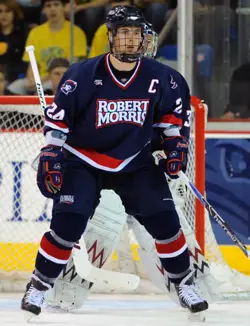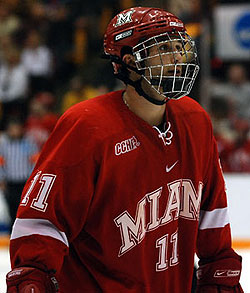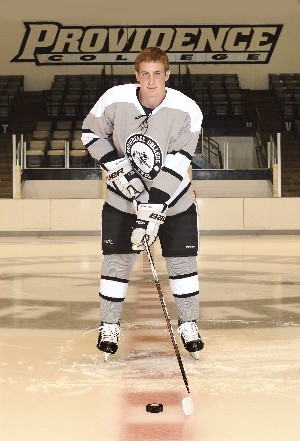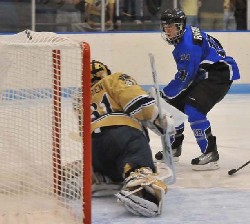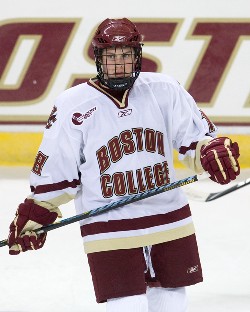Beginnings, Auspicious and Otherwise
Not with a bang, but with a whimper. Or, maybe, a tiny yelp. Not very loud. A smallish hooray.
It was the proverbial mixed bag in the opening weekend for the CCHA, with clear-cut winners, out-and-out losers, and teams that were somewhere in the middle.
Congratulations to the Nebraska-Omaha Mavericks, this year’s Ice Breaker Champions! The Mavs scored 10 goals in wins over Army and Massachusetts-Lowell, allowed 20 or fewer shots on net in each contest, and produced the tournament MVP, junior Rich Purslow (2-2–4).
And congratulations to the Alaska Nanooks, who captured the Kendall Hockey Classic with wins over Michigan — Michigan! — and Mercyhurst. Not only did the Nanooks defeat the Wolverines, a team they’d lost to 37 times in 41 meetings — but they shut them out, 2-0. UAF sophomore goaltender Scott Greenham was the MVP of the tourney.
Two CCHA teams swept nonconference opponents in non-tournament play, so thank you Miami and Michigan State.
Two CCHA teams were swept by nonconference opponents in non-tournament play. Bowling Green dropped two to Minnesota State on the road, and Ohio State lost two at home to Quinnipiac … so, thank you, Buckeyes, for making everyone who picked you to finish fourth this season — coaches and media alike — to question their early October sanity.
And then there’s the rest of the pack, everyone else who played and split. In all, the CCHA went 12-8-0 against nonconference opponents last weekend, providing anything but a definitive opening statement.
At least the league went 6-4-0 against the WCHA. That’s gratifying, for the moment.
Speaking of Gratification
They came not merely to play, not merely to win. The Alabama-Huntsville Chargers came to South Bend to prove something. The shame of it is that they’re the only ones who think they have something to prove.
The Chargers split their weekend against Notre Dame, knocking off the defending CCHA regular-season and playoff champs, 3-2, Friday night before dropping a 3-1 decision Saturday.
When Tom Train scored for UAH at 13:13 in the second Friday to tie the game 1-1, the team and Chargers faithful reacted as though they had struck a blow against the Great Forces of Darkness. After Huntsville won, I heard a common refrain among the Chargers’ fans, family relations, and even some players: “Are we good enough now?”
It wasn’t plaintive; it was defiant. And because there wasn’t a single CCHA fan in attendance who wasn’t sympathetic to UAH’s cause, because every coach in the league would gladly have taken the Chargers had the votes been up to them, because every CCHA player wouldn’t mind a trip to Huntsville in February — and even because this CCHA beat writer has been banging the drum for UAH since we all saw the CHA writing on the wall — the sentiment was kind of, well, silly.
Understandable, given human nature, yes. But silly, since no one in attendance was, in fact, the enemy.
UAH coach Danton Cole — a Pontiac, Mich. native who played for Michigan State (1986-89) — said that he and his coaching staff did not look upon the weekend series with Notre Dame as some sort of grudge match but admitted that maybe there was some residual bad blood “for the players.”
“For us, it’s nothing we’ve really talked about in terms of, ‘Let’s go make a statement,'” Cole said. “Every game, we need to play a certain way and live up to that level of play and kind of build that kind of culture where regardless of who and where we’re playing. That’s been our focus.”
Cole said that he and the coaching staff addressed the CCHA’s vote at the beginning of the year at a team meeting and then told the Chargers to put it behind them. “We’re going to put a great independent schedule together [for 2010-11] and that’s what we’re going to do — and that’s been the end of it. I’m a CCHA guy. I grew up a season ticket holder for a bunch of years, and I played there and have a lot of really good friends there.”
In the end, Cole said, “We showed up and worked hard.” That’s why the Chargers won Friday’s game; they outworked the Fighting Irish.
“I’ve been on the other side of those games before,” Notre Dame coach Jeff Jackson said. “I know how they are. It’s a monumental game for them; [the players] want to make a statement, and they did. Danton had them well prepared and I thought they played extremely hard.”
As for dropping the opener, Jackson said, “It’s the first game of a long season.”
More on That Gratification Thing
I told you that there was more to the CCHA’s vote on Huntsville than anyone knew. As it turns out, there was a juicy piece of the puzzle missing from information I had when I wrote about it in August.
There was serious talk about a Big Ten hockey conference this summer. This week, Andy Baggot published a story on Madison.com, online home of the Wisconsin State Journal and the Cap Times, about the talks surrounding the formation of a Big Ten hockey conference, from which a hero has emerged who should be familiar to CCHA fans: Minnesota athletic director Joel Maturi.
Maturi, former athletic director at Miami, is the voice of reason among Big Ten schools with hockey programs. In essence, Maturi said that Minnesota would not be in favor of such a conference.
Not surprisingly, The Ohio State University is all for it. Quoted in the article, Chris Schneider, an associate athletic director at OSU, said that a Big Ten hockey conference is something people in Columbus would “like to see accomplished.”
This is unsurprising on two levels. First, The Ohio State University is all about revenue. Second, the Buckeyes don’t get to play Wisconsin and Minnesota annually, as the other two CCHA/Big Ten hockey schools get to do.
Another hero to emerge from these talks was Wisconsin head coach Mike Eaves. Apparently, there was real talk of the Badgers leaving the WCHA for the CCHA, but Eaves wisely quashed this.
All of this is nutty — real, actual, but nutty. And it’s not over. Everything about collegiate sports is driven by money. Sure, there are purists among the fans, coaches, players, etc., but make no mistake about this being big business. If there’s a better way to make a buck off of the little niche sport we’ve come to love so well, someone will find a way to do it … and force it into existence.
Baggot’s story should give some comfort to those good folks in Huntsville who think that the CCHA deliberately snubbed them for not being good enough. It just isn’t about UAH. In addition to the Big Ten nonsense and pressure to somehow make the sport more profitable in really bad economic times, half the schools in the CCHA are located in Michigan, the state that’s been hit harder economically than any other in the U.S., the state with the highest recorded unemployment in the country.
Maybe it’s better in northern Alabama, but here in Michigan, there are whole academic institutions struggling to stay afloat. I am not exaggerating. When a college or university is worried about staying viable, it may have reservations about committing to anything it thinks may further strain its budget — including the acceptance of a hockey program struggling to stay afloat.
Folks, there’s just much more to this than any of us knows. To paraphrase someone close to the story, it’s so hard to know who to trust. And so few people want to go on the record.
Gratification, Part 3
“So — we got a sweep? Amazing.” So said Michigan State senior Nick Sucharski after the Spartans beat Clarkson back-to-back. It was particularly gratifying to Sucharski, who had to sit out last season with a shoulder injury.
“The boys deserve it, I think,” Sucharski said. “It was fun as anything. We haven’t had a sweep in a long time, and it was a good feeling to get back on the right track, and it’s something we look forward to happening many times this year.”
The Spartans did not beat one single opponent in consecutive games last season, and their last sweep of a single opponent in a single weekend was a home-and-home sweep of Bowling Green, Feb. 29 and March 1, 2008; their last home sweep of a single opponent was Nov. 9-10, 2007, against Mercyhurst.
“I think we have a little bit more of an aggression about us and guys are willing to work,” Sucharski said. “You’ve got to fight to be in the lineup, and not only do you have to fight to be in the lineup, but you have to fight to be in the special teams.”
And the special teams were special. MSU went 5-for-16 against Clarkson last weekend; the Spartans scored just 20 power-play goals for all of 2009-10. On the weekend, Michigan State netted 10 goals in two games; last year, they had 62 goals total.
After Saturday’s 4-3 win, coach Rick Comley said: “We’re going to be in a lot of close games. We hurt ourselves with some avoidable penalties, obviously, a little bit sloppy that way. Hard fought. Good opening weekend. Gives us something positive to build on.”
A Weekend of Firsts
Many CCHA players recorded their first collegiate goals in action last week. Congratulations to freshmen Chad Gehon (UAF); Eric Alexander, Kyle Bonis and Travis Ouellette (FSU); Devin Mantha and Curtis McKenzie (Miami); Chris Brown (UM); Derek Grant, Zach Josepher and Chris Forfar (MSU); Terry Broadhurst (UNO); Kyle Palmieri and Riley Sheahan (ND); and Alex Carlson (OSU).
Congratulations, too, to Nebraska-Omaha’s Dean Blais on his first wins as a CCHA coach.
Congrats also go to Alaska sophomore goaltender Scott Greenham, whose Friday night shutout of the Wolverines was the first in Nanook hockey history.
When Lake Superior State beat Michigan Tech, 3-1, Saturday, it was the first win for the Lakers in the three-year history of the Superior Showcase. The Lakers are now 1-3-2 all time in that season-opening event.
And Ohio State’s sweep at the hands of Quinnipiac marked the first time since the 2004-05 season that the Bucks lost their two season-opening games. After those losses — to New Hampshire and St. Cloud State in the Ice Breaker — the Buckeyes managed to put together a season that earned them an invitation to the NCAA tournament.
As Jeff Jackson said, it’s a long season.
Not a First, but a Milestone
Congratulations to Comley, who recorded his 750th career win with the Spartans’ 6-1 decision over Clarkson last Friday.
Early Impressions
I managed to get to South Bend for the UAH win over Notre Dame Friday and East Lansing for Michigan State’s nightcap against Clarkson. Here are a few observations and other tidbits from the weekend:
• The Spartans are much improved. That’s perhaps a given. What I didn’t expect is how fun the freshmen would be. Derek Grant is impressive.
• Another freshman who made an impression is Notre Dame’s Riley Sheahan. I loved the chemistry between him and Ryan Thang Friday.
• Both the Irish and the Spartans are teams that will take a bit of to adjust to life after franchise goaltenders. It’s hard to replace goalies like Jordan Pearce and Jeff Lerg; it’s harder still to remember that they’re not in net. Both ND and MSU have younger blue lines that will learn to protect the goaltenders that they are unaccustomed to seeing in net.
• Both Notre Dame junior Brad Phillips and Michigan State senior Bobby Jarosz played well in the games that I saw. Both made many good first and second saves before leaving open back-door opportunities. They were solid, and it was good to watch someone new in net in each building.
• That having been said, it was good to see Jeff Lerg in the press box in East Lansing. Lerg, recovering from surgery, will be helping out with the Spartans until about midseason, when he’ll rejoin the New Jersey Devils organization.
• The Alabama-Huntsville Chargers have the sweetest ride I’ve ever seen. They travel in a tricked out tour bus with enough bunks for every player and a separate coaches’ room in the front. The driver has been with Cole for 11 years, since Cole’s first season as an assistant coach with the Grand Rapids Griffins.
• Is it too late for me to swap OSU and MSU in my preseason polls?
